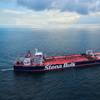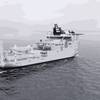Podded Propulsion Goes Beyond the Cruise Realm
In some segments, most especially the domain of large cruise vessels, the podded option has forever altered the established position of standard propulsion arrangements. As has been witnessed over the past 12 months, an ever-widening appreciation of the merits of podded electric propulsors has spread the reference list to new areas, including crude oil tankers, survey ships and offshore support vessels. Soon, the concept will make its seagoing debut in the RoRo ferry sector.
From establishing a commitment to 'power station'-type plant and electric propulsion drives, it can be just a short, further step to fostering the adoption of a pod. This remarkable, generic device encapsulates the electric motor and can deliver full thrust in any direction, dispensing with the need for conventional shaftline, propeller and rudder.
Intense competition between a handful of producers, in each case melding the expertise of specialists in electrical engineering and propulsion co-venturers, is of itself enhancing the scope and the attraction of podded systems, through design development and a solution-based approach to new powering and propulsion options. For instance, pods are now being proposed within hybrid systems to meet the powering needs of the envisioned breed of ultra-large containerships, while new design variants have been developed specifically for smaller-ship applications, bringing major new areas of the market within the ambit of podded drives.
Superior maneuvering capabilities, increased hydrodynamic and drive system efficiencies, overall energy gains, and the shipboard space savings and design flexibility associated with electric pod propulsion give a solid foundation to consideration of the podded options. Building on a long track record in thruster technology, and underscoring a propensity for maritime innovation, the Finns were the leaders in the podded drive concept. The first contractual reference for the Azipod system originated by ABB Industry and Kvaerner Masa-Yards (KMY) gave the design its operational debut in 1991.
While various specialized vessels for ice navigation have carried the concept forward, the large-scale recourse to the system by leading operators in the cruise shipping sector within the past few years has constituted one of the outstanding aspects of propulsion system development over the past decade. Since 1997, the business activities for the system have been managed by ABB Azipod of Helsinki, in which ABB Industry is the majority shareholder, complemented by hipbuilders KMY and Fincantieri. One of the champions of diesel-electric powering, Carnival, gave podded propulsion its start in the cruise ship domain with the commissioning of the Elation and Paradise in 1998, sparking broader industry uptake of the concept. Subsequent problems experienced with the systems, which led to an out-of-court settlement between ABB Azipod and Carnival at the end of last year, prompted certain design modifications.
By the end of May this year, Azipod installations had been specified for 24 cruise vessels, encapsulating a total of 53 pods, and involving newbuild commitments extending into 2005. While Royal Caribbean's Vantage series from Meyer Werft field the biggest unit power concentrations of 19.5-MW per pod in twin Azipod applications, the same U.S. group's Voyager of the Seas class from Kvaerner Masa-Yards have the largest array of power through the adoption of three pods of 14-MW apiece. The design offering now extends through the performance range up to 25-MW, and has been strengthened in the sector up to 5-MW by the development of the Compact Azipod series.
A market breakthrough has been achieved with the specification of the first podded propulsors specified for large crude oil carriers, whereby a 16-MW Azipod will be used for each of two 106,000-dwt diesel-electric tankers ordered in Japan for deployment with Fortum Oil & Gas.
The heavily ice-strengthened vessels will serve the Finnish energy group's year-round transportation of crude oil from the North Sea basin to its Baltic refineries. The project provides a breakthrough in the large tanker sector for Kvaerner Masa-Yards' double-acting technology, which champions the concept of podded drives. Podded propulsion is central to double-acting technology, whereby vessels are formed and equipped to sail astern in icebound waters, permitting the use of a hydrodynamically-optimized bow for open-water navigation.
Fortum has the most extensive seagoing service experience to date of any user of podded propulsors, through its Nemarc Shipping joint venture with KMY. Nemarc's two 16,400 dwt Arctic tankers Uikku and Lunni were each retrofitted with a 11.4 MW Azipod in 1993 and 1995, respectively.
The tankers have been booked with Sumitomo Heavy Industries, where they will be constructed to the Finnish Maritime Administration's Ice Class 1A Super requirements, and incorporate a hull structural design based on a 40-year fatigue life. By developing a system tailor-made for smaller vessels, ABB has increased the market reach of innovative podded propulsion technology. The Compact Azipod design has been engineered by the Finnish group for unit power applications in the 400-kW to 5-MW range, and early contractual successes in the offshore field have been followed by survey ship applications for the U.K. Ministry of Defence. While encapsulating the concept and attendant benefits of the original Azipod series, the latest system incorporates distinct features influenced by the particular design and operating needs of a very large population of small vessels, including ferries, inland vessels, coastal and offshore service vessels. Enhanced maneuverability and operational economy have been the twin objectives have been cornerstone objectives in the Compact Azipod development project.
It is felt that market demand for the compact, water-cooled unit could reach several hundred units per annum within just a few years.
The adoption of a permanent magnet motor not only allows a slimmer pod and promises higher electrical efficiency, but also obviates cooling on the rotor, while the stator is cooled by convection to the surrounding seawater. The standard, single-propeller system can be delivered as either a 'pulling 'or 'pushing' version, and the pushing variant may be fitted with a nozzled propeller to give a higher bollard pull rating.
The distinctive propulsor type has been selected for three multi-role support vessels contracted from a west Norwegian shipyard by the Ulsteinvik-based company Island Offshore. The recipient, diesel-electric newbuildings will be of the UT745E type, drawn up by Rolls-Royce Marine.
With the 4,000-dwt first-of-class due for handover this year by Soviknes Verft, the versatile support vessel class features with two pulling-type Compact Azipod units dimensioned and powered for an output of 2,300 kW apiece. The project also signifies a new application, in a demanding operating scenario, for ABB's new, water-cooled ACS600 Marine Drive, a key constituent of the Compact Azipod.
The first Royal Navy vessels incorporating integrated electric propulsion and Azipod propulsors will be the survey vessels HMS Echo and HMS Endurance, which are being constructed by Appledore Shipbuilders under subcontract from Vosper Thornycroft (UK). Each vessel will be equipped with two PWM (pulse width modulation)-controlled Compact Azipod units rated at 1,700-kW each, as part of a broader package of supply by ABB also encompassing the generators for the main power plant.
The prestigious contract to supply four Mermaid pod systems to the nascent Queen Mary 2, the 150,000-gt luxury cruise liner booked from Chantiers de l'Atlantique for Carnival's Cunard Line brand, has taken the sales tally for the series to 40 units. Originally parented by Kamewa and electric drive specialist Cegelec, now respectively vested in Rolls-Royce and Alstom Power Conversion, Mermaid has also recently been nominated for NYK's 68,000-gt cruise ship newbuild at St. Nazaire, and also for the 60,000-gt sisters placed with the same yard by Italian operator MSC Cruise.
The Queen Mary 2 project signifies application of the technology at an unsurpassed level of power, whereby the installation will comprise two fixed and two azimuthing pod units of 21.5-MW each, delivering a combined output of 86-MW. The arrangements are designed to ensure a speed of nearly 30-knots with low noise and vibration levels and maximum maneuverability.
The Mermaid range covers unit powers up to 25-MW, and has hitherto been sold in versions from 7-MW upwards. The proprietors plan to introduce drives starting at 500-kW, cognizant of the considerable small-ship market potential for pod propulsors. The 85,000-gt Millennium-class cruise ships entrusted by Celebrity Cruises to Chantiers de l'Atlantique provided the debut for the Mermaid as well as for the gas turbo-electric powering concept in the cruise sector.
Mermaid has also been favored for the Project America initiative, whereby two 12.5-MW units will be supplied in each case to two 72,000-gt cruise ships to be constructed by Litton Ingalls Shipbuilding for American Classic Voyages Co. (AMCV). The propulsor choice is all the more significant for the fact that the newbuilds are the first large, ocean-going passenger ships to be laid down in the U.S. for 40 years.
Swedish tanker operator Donsotank has re-affirmed its belief in podded electric drive technology by nominating a Siemens-Schottel Propulsor (SSP) system for a further chemical products carrier to be built in China.
The latest diesel-electric newbuilding will be a near-sister of the 18,000-dwt Prospero, commissioned from Shanghai Edward Shipyard last September. Prospero provided the all-German SSP concept with its first seagoing reference, by way of a 360-degree rotating pod incorporating a 5.1-MW electric motor.
Ease of fitting, a factor salient to its adoption for a project in China, was one of the characteristics of the integral drive system, which favored its selection for the new tanker. The SSP's modular design and, unlike other podded drives, its avoidance of complicated air cooling arrangements, makes for relatively straightforward installation. The SSP solution differs from other podded propulsion options by way of the use of tractor and pusher propellers at each end of the pod unit. It is also distinguished by the adoption of a permanent magnet, longitudinal-flow motor. Each end of the armature is direct-coupled to a propeller, such that the two propellers rotate in the same direction. Donsotank's second-of-class from the partially German-owned Shanghai Edward establishment is scheduled for handover at the beginning of 2002.
TT-Line of Germany has provided an opening reference for podded electric drives in the ferry market, a project which has drawn considerable media attention for the ship handover delays attributable to problems encountered with the SSP pod system on sea trials. At the time of writing, with the 34,500-gt Nils Holgersson being readied at Bremerhaven for a delayed commissioning in July, the precise nature and cause of problems had still to be made known. However, the concept holds good, based as it is on solid operational and economic factors.
The exacting level of maneuverability needed for the new ships, the savings in fuel associated with more efficient maneuvering, along with weight, space, and propulsive efficiency factors favored the selection of azimuthing pods in preference to a more standard diesel-electric layout based on internal propulsion motors driving fixed-pitch propellers. The nature of the SSP system, whereby machine cooling is effected principally by direct seawater contact with the pod body, so dispensing with the need for special cooling equipment and space provision, is regarded as a plus factor in RoRo ferry design.
Using 11-MW SSP10 pods, the system has been incorporated into its new class of RoPax ferries within the limited height constraints imposed by the aft-end configuration of such vessels, and the need to ensure unobstructed access from the stern ramp into the main garage deck.
With the sales tally growing for the competing Azipod, Mermaid and Siemens-Schottel Propulsor (SSP) design series, STN Atlas Marine Electronics and John Crane-Lips have demonstrated the market's receptivity to a further propulsion option by landing an opening deal for the jointly developed Dolphin pod system.
Radisson Seven Seas' 50,000-gt newbuilding Seven Seas Voyager, will provide the debut contract for the Dolphin series, in the form of two 7,000-kW pods. The units figure in a considerably broader powering and drive package to be supplied by STN Atlas and John Crane-Lips to Genoese yard of build T.Mariotti.
The co-developers claim that a typical Dolphin installation can result in power savings of 5-10 percent relative to conventional propulsive drive arrangements based on fp propellers. The pulling action of the podded propulsor makes for an improved axial water flow towards the propeller compared with a traditional twin-screw, inboard-drive arrangement. As well as reduced propulsive energy requirements at a given ship speed, the podded option is said to result in improved cavitation characteristics with low excitations, and a low noise level.
The heart of the Dolphin is a six-phase, brushless, synchronous motor incorporating double windings, and speed-controlled by converter. The concept has been engineered for operational reliability and system simplicity. The shaft is protected within its pod casing by a combination of face and lip seals. Dolphin's Dutch and German technicians have developed systems for applications in the 3-MW to 19-MW power band. The diesel-electric Seven Seas Voyager, arranged for 700 passengers, will be similar to the Mermaid-fitted Seven Seas Mariner, completed this year by Chantiers de l'Atlantique. Options available to shipowners and designers have also been increased by the development of a new pod design by the French state-owned undertaking DCN. Although conceived for the naval sector, DCN's primary marine market, the system is also claimed to offer substantial potential in the mercantile vessel field. Using a permanent magnet motor-based solution and employing a pulling-propeller configuration, the French offering is understood to match the broadest power range currently available with existing podded drives.
Meanwhile, a three-year research program drawing in European and U.S. participants, and dubbed Pods in Service, is expected to yield valuable data that will help quantify operational performance with podded systems and feed into future design work. The project is being coordinated by the Dutch Maritime Research Institute MARIN.











